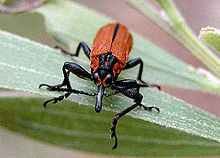Belidae
| Belidae Temporal range:
| |
|---|---|

| |
Rhinotia hemistictus
| |
| Scientific classification | |
| Domain: | Eukaryota |
| Kingdom: | Animalia |
| Phylum: | Arthropoda |
| Class: | Insecta |
| Order: | Coleoptera |
| Infraorder: | Cucujiformia |
| Clade: | Phytophaga |
| Superfamily: | Curculionoidea |
| Family: | Belidae Schönherr, 1826 |
| Subfamilies | |
|
Belinae | |
Belidae is a

Distribution
The Belidae today have an essentially Gondwanan distribution, occurring only in the Australia–New Guinea–New Zealand region up to Southeast Asia, South and Central America (barely reaching North America), some Pacific islands (notably the Hawaiian Islands) and a few places in Africa. Many lineages of belids are notable for their highly relictual distribution; for example the Aglycyderini are found in two areas on opposite sides of the Earth, with no such beetles known from anywhere in between.[1]
Belids were more widespread during the Late Jurassic to Early Cretaceous, about 161 to 100 million years ago, when they were found at least in Central Asia, Spain and Brazil.[2] Paleogene species belonging to still-living tribes are known from Europe and North America.[1]
Description

Members of the subfamily
The adults are distinguished from other ancient weevil lineages by some characteristic traits: The fore
The endocarina is V-shaped. In most, the antennae have a retractable membrane at the base (not in
Ecology

Adults usually eat
The original host plants of belids were probably
Systematics
The
Extinct taxa
- †Daohugou, China, Callovian
- Subfamily Belinae Schoenherr 1826
- †tribe Davidibelini Legalov 2015
- †Davidibelus Zherikhin and Gratshev 2004 Crato Formation, Brazil, Aptian
- †subfamily Montsecbelinae Legalov 2015
- †tribe Montsecbelini Legalov 2015
- †Montsecbelus Zherikhin and Gratshev 1997 La Pedrera de Rúbies Formation, Spain, Barremian
- †tribe Montsecbelini Legalov 2015
- Subfamily Oxycoryninae Schoenherr 1840
- †Khetana Zherikhin 1993 Emanra Formation, Russia, Turonian
- Clade Aglycyderitae Wollaston 1864
- †tribe Distenorrhinoidini Legalov 2009
- †Distenorrhinoides Gratshev and Zherikhin 2000 La Pedrera de Rúbies Formation, Spain, Barremian
- †tribe Distenorrhinoidini Legalov 2009
- Clade Allocorynitae Sharp 1890
- Tribe Allocorynini Sharp 1890
- †Pleurambus Poinar and Legalov 2014 Dominican amber, Miocene
- †tribe Palaeorhopalotriini Legalov 2013
- †Palaeorhopalotria Legalov 2013 Monteils Formation, France, Priabonian
- Tribe Allocorynini Sharp 1890
- Clade Oxycorynitae Schoenherr 1840
- Tribe Metrioxenini Voss 1953
- Subtribe Metrioxenina Voss 1953
- †Archimetrioxena Voss 1953 Baltic amber, Eocene
- Subtribe Zherichinixenina Legalov 2009
- †Paltorhynchus Scudder 1893 Green River Formation, Florissant Formation, United States, Eocene
- †Succinometrioxena Legalov 2012 Baltic amber, Eocene
- Subtribe Metrioxenina Voss 1953
- Tribe Metrioxenini Voss 1953
- †tribe Davidibelini Legalov 2015
References
- ^ doi:10.1071/IS05059.
- ^ a b Liu Ming, Ren Dong & Shih Chungkun (2006). "A new fossil weevil (Coleoptera, Curculionoidea, Belidae) from the Yixian Formation of western Liaoning, China". Progress in Natural Science. 16 (8): 885–888.
External links
 Data related to Belidae at Wikispecies
Data related to Belidae at Wikispecies- Belidae on web.archive.org
- Images of Belidae species in New Zealand
